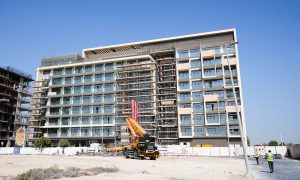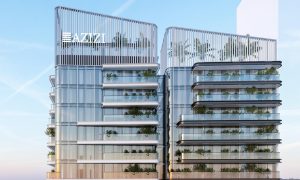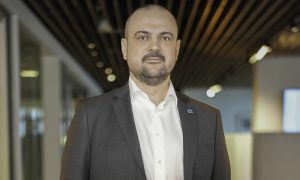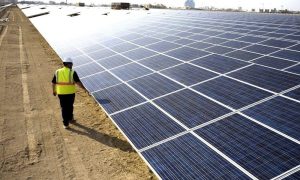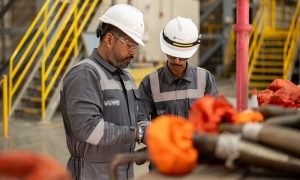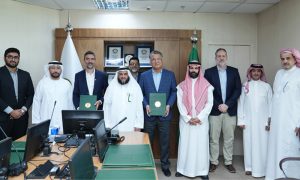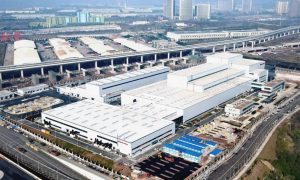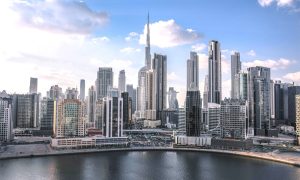Facades Smarten Up
Can innovative facades change how our buildings perform? Neha Bhatia investigates how science is improving the functionality of façades.

RELATED ARTICLES: Use of nanotechnology underway in Qatar’s facade market | How to build an office block | Structurally Sound Future
GCC construction markets are riding high in anticipation of the two global megaevents coming to the region within the next decade. Energy efficient practices are now leading the construction industries in the region and sustainability targets are now being implemented for every element that goes into the creation of a structure.
Technology has crept into the workings of the construction industry, and façades have greatly benefited from this advancement.
“The skin of a building has a profound effect on its performance. Simply put, an intelligent façade uses physics to control and make the best of what’s given by Mother Nature,” Matt Kitson, regional director for Hilson Moran’s operations in Qatar tells Big Project ME.
“The façade’s performance impacts the mood of the people living or working in the building; a good façade can even promote energy efficiency in the building.
“In the early days, you had things like soft coatings on double-skin glass to cut out 70% of the heat from entering the building or allow 50% of the sunlight in,” Kitson recollects.
“Projects in Germany introduced me to double-skinned façades. Each of these techniques were clever at the time, but the market has changed since the time.”
Change there has been, indeed. Intelligent façades are now becoming the first-choice for some environmentally-conscious pockets of the GCC’s construction markets, and traditional façades are being made to adapt to the local climate conditions in the region.
“A derivative of nanotechnology which has been around for a while has now been licensed in Qatar, and we’re currently testing it out on one of our projects,” Kitson reveals. “It entails the use of paint, which is manufactured by Japanese research labs working for their national space agencies to protect the nozzle of their rockets from externalities such as dust and deflect sunlight too.
“The paint is basically applied on the tip of rockets, and we’re now using canisters of that paint to coat the buildings we’re working on,” Kitson proudly continues. “The whole process employs a really cool science, but in reality is as simple as some paint in a tub being used innovatively. We’re yet to see how it impacts the overall building performance, whether it’s available in other colours and other such factors, but this idea could have a huge impact on the industry, especially for residential projects like small buildings and villas. It is quite commercially viable, I can tell you that.
“Another technology we’re keen on bringing into the Qatari market is electro-chromic glass, which contains photo voltaic cells that enable the transition of a façade’s appearance and rate of sunlight deflection,” Kitson reveals. “We’re working with our partners here to hopefully use this glass on some of the World Cup 2022 projects too. It is a very relevant alternative for sectors which comprise of high-rise towers with glass façades, and it is also becoming very economical by industry standards now.”
However, enhancing energy-efficiency through façades will require more than just such simple solutions. Agnes Koltay is the founder of Koltay Façades Engineering, a consultancy she launched in 2011 after 15 years of experience with multinational firms in both,
Europe and Dubai. Speaking to Big Project ME, Koltay insists the definition of an ‘intelligent’ façade is more complex than it is currently viewed as in the local construction market. “In my definition, every façade is intelligent if designed with awareness of the local climate and solar conditions, and suitably implemented,” she says. “The same, simple glazed façade can provide very good energy efficiency, natural light conditions, air and water sealed enclosure,” Koltay says. “It depends on how the façade is designed, built, oriented, framed, placed, interfaced and combined.
“Otherwise, intelligent façades are either climate adaptive (responsive) façades, where solar or thermal conditions may trigger a change; or façades with a secondary function designed in, such as energy creation or heat exchange or ventilation.”
One such façade system, according to both, Koltay and Kitson, is the one created for Al Bahar Towers in Abu Dhabi, UAE. Giorgio Buffoni, an associate in the façade engineering department of Arup briefs Big Project ME on how the Al Bahar façade was put together.
“Whilst working on Al Bahar Towers, one of the references we frequently used was the movable shading system installed at Medina in Saudi Arabia, made of big umbrellas installed a few years ago and still perfectly functioning,” Buffoni reveals. “One of the first interesting examples of intelligent and adaptive building is the Institute of Arabian Affairs in Paris, designed by Jean
Nouvel. A more recent example is the Media- TIC in Barcelona, by Enric Ruiz-Geli. “A fully functional 1:1 scale prototype was built and tested in a wind tunnel facility and in a climatic chamber,” Buffoni adds. “More than 30,000 opening/closing cycles were simulated at different temperature ranges, applying sand and salted water on all the critical joints. This process was essential to demonstrate that the concept was feasible.”
Buffoni’s revelation about how Al Bahar’s façade system was created sheds light on the need to put offbeat and unconventional methods to test. In a region where building tall is a natural instinct, it is critical to consider the safety aspect of those installing façades onto the towers spanning dizzying heights.
“Intelligent façade installation does not necessarily need extra skills, but needs the collaboration of a number of different skillsets,”
Koltay opines. “This means people need to closely coordinate and collaborate to achieve a complex and integrated end product.
“The same goes for façade design: façade engineering combines structural, architectural, fire safety, acoustic, material science, building physics, electrical and other such disciplines,” she says.
“My background in construction lies in MEP engineering,” Matt Kitson adds. “I gradually moved to façade engineering when I found the amalgamation of disciplines it requires.
“Sometimes, you come across clients who are more aware of the ‘intelligence’ aspect of façades and other such units. The lower you move down the food chain, you’re less likely to find such awareness,” he continues.
“Unfortunately, solid communication channels are rarely established between the main contractor and other project parties.”
Kitson explains the communication breakdowns which may plague an ambitious project in the region.
“For instance, the architect and engineer may have been procured through a tender released separately from one for the main contractor. Furthermore, architects and engineers are rarely in charge of on-site supervision.
“In such a scenario, they may find that their project designs have not been implemented as required, either because the subcontractor was not adequately explained about the project demands, or the builders undertook ‘value engineering’ without prior approval.
It’s a shame when this happens,” Kitson rues. Buffoni echoes these opinions, attributing the success of Al Bahar Tower’s façade systems to the project’s developers, the Abu Dhabi Investment Council. “All the different parties need to be fully committed and ready to start a ‘journey’ together. This includes first of all the client – Al Bahar Towers was possible thanks to an enlightened client team,” Buffoni says.
“The design team, the main and the specialist contractors all need to be trained, and they need to have the required skills to collaborate with the design team at each stage of the process,” Buffoni continues. “If it is true that all projects are different, this is even truer for dynamic and adaptive buildings.
Most of the time, they are based on unique and innovative concepts, and they need to be approached with this spirit in mind. A ‘copy and paste’ from something designed by someone else would never work.”
The local construction market in Dubai and the rest of the UAE has often been criticized for being technologically backward when compared with its European counterparts.
Koltay, however, refutes this belief, appealing for a more holistic and organic view of the local markets and their operations.
“I don’t think the Dubai market is behind Europe at all,” she exclaims. “The problems in Europe are very different; theirs is not an extreme environment. It isn’t predominantly marine or dusty, and their systems are made to work for those environment conditions.
They’re therefore more likely to use doubleskin façades, since their motive is to increase natural lighting in their buildings. Electricity is also far less affordable there than it is in, say, Dubai,” Koltay explains.
She contrasts this with the Dubai and Middle Eastern construction environments.
“The biggest challenge in the region is dust. Fine sand can block movable parts easily,” Koltay says. “Even for fixed features, dust would collect and necessitate more frequent and thorough cleaning. You can often see buildings with dust collecting on the external shading elements or dusty, non-accessible glazing behind such shading. The necessity of cleaning and maintenance access is often neglected until the last phase of the project, when it may be too late to develop an optimal strategy.
Other challenges here are the corrosive marine environment combined with high UV exposure and high surface temperatures.
“You can’t copy everything European designers are doing,” Koltay warns, “else you could end up with much worse results than accounted for.”
